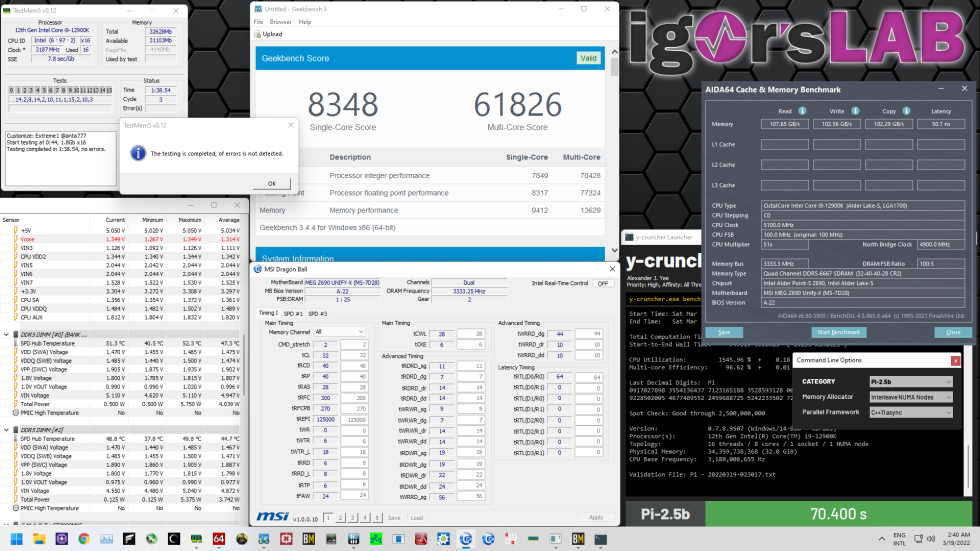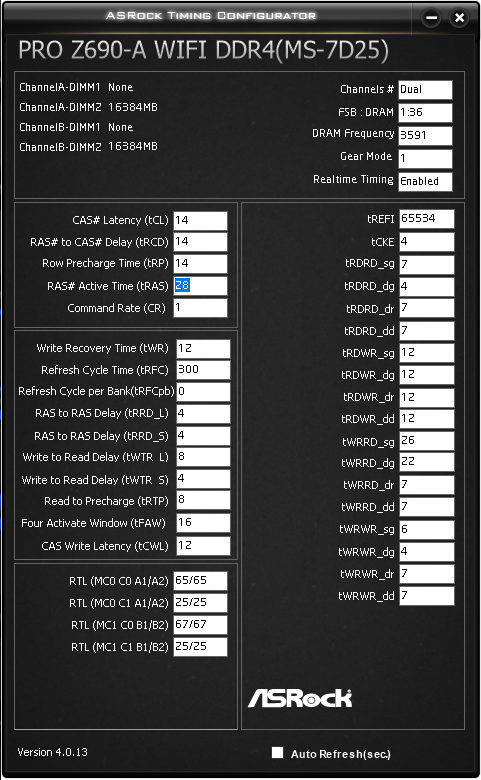Overclocking – 6666 CL32 2T
An Intel Core i9-12900K CPU is used as the test system, overclocked to 5.1 GHz on the P-cores, 4.9 GHz on the cache and disabled E-cores. Although our CPU supports the AVX-512 instruction set, it remains deactivated for the tests, since later Alder Lake CPUs (including new 12900K) are no longer allowed to do so by Intel. On the one hand, the Asus Maximus Z690 Apex acts as the motherboard for the heat tests with its DIMM slots close to each other and for reading out the SPD information. For the overclocking and the performance tests, the MSI MEG Z690 Unify-X is used, with BIOS A22, due to the better repeatability.
Unfortunately, the Corsair Dominator Platinum RGB modules cannot be overclocked quite as high as the ADATA XPG Lancer, which is also equipped with Hynix M-Die, DDR5-6666 in contrast to DDR5-6800. Unfortunately, further loosening of the timings or more voltage don’t help here either. In return, however, they can be adjusted relatively tightly, whereby no active cooling was used. Especially the very tight tCWL of 28 (tCL – 4), the tRDRD timings of 11/7, tWRWR timings of 9/7 and tWRRD timings of 56/44 make up for some of the performance that the somewhat loose primary timings initially leave on the wayside. Even after hours in various stress tests, the warmer module does not reach 55 °C in the SPD Hub temperature.
We cannot say for sure why the modules cannot be clocked as high as Hynix M-Die variants from other manufacturers. CPU and motherboard are capable of more, but the proverbial Silicon Lottery could simply throw a spanner in the works here. However, since the modules cannot be stabilized at 6800 Mbps even when tested individually, a peculiarity in the board design could be behind the clock wall in addition to great bad luck. However, we cannot say for sure. By the way, our modules cannot be stabilized with Command Rate 1T either without having to accept large setbacks in the clock and thus the overall performance. Thus, as with the XMP profile, we tested with Command Rate 2T and of course Gear 2, as it is necessary for DDR5.
The full list of hardware used follows as always:
|
Test systems |
|
|---|---|
| Hardware: |
|
| Cooling: |
|
| Housing: |
|
| Periphery: |
|
| Measuring devices: |
|
For better clarity, the following abbreviations are used in the diagrams:
- 12900K: Intel Core i9-12900K CPU
- 51/0/49: Multipliers for P-cores x51, E-cores 0 (deactivated), cache x49 at BCLK 100 MHz
- XPGL: XPG LANCER RGB DDR5 modules from ADATA
- DPR: Dominator Platinum RGB DDR5 modules from Corsair
- FB: Fury Beast DDR5 modules from Kingston
- DR: Dual-Rank, if not specified Single-Rank
- 3600c14: configuration with 3600 Mbps and tCL timing 14, see screenshots for all timings
- 1T, 2T: Command rate 1T or 2T
- *: completely manually set subtimings, see screenshots
- G1, G2: Gear 1, Gear2 – ratio between IMC clock and RAM clock, Gear 1 = 1:1, Gear 2 = 1:2
- H16M: SK Hynix 16 Gbit M-Die memory chips
- S16B: Samsung 16 Gbit B-Die Memory Chips
Timings of the DDR4 comparison config:




































Bisher keine Kommentare
Kommentar
Lade neue Kommentare
Artikel-Butler
Alle Kommentare lesen unter igor´sLAB Community →